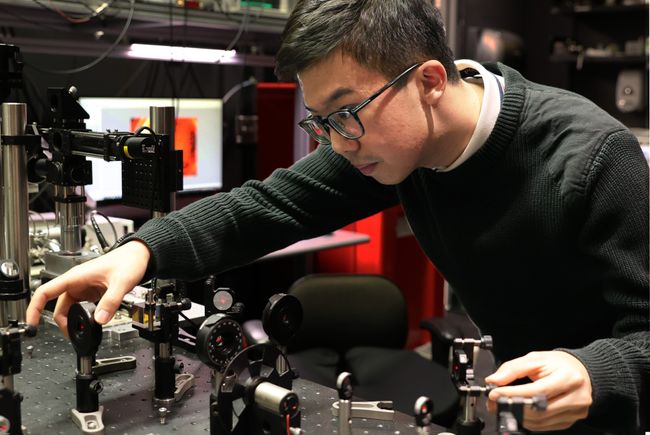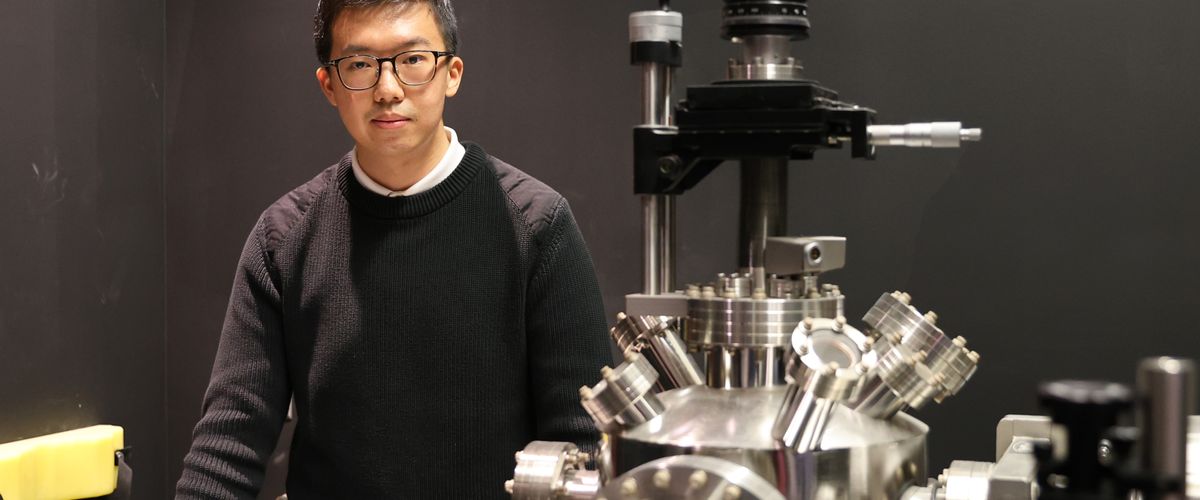Monan Ma: Making Big Waves with Nanotechnology in the Ekinci Lab
Monan Ma researches phenomena on the nanometer scale, but he’s no small figure at the Boston University Photonics Center. As a PhD student studying Mechanical Engineering in Professor Kamil L. Ekinci’s lab, Ma has already conducted research as a BUnano Cross-Disciplinary Fellow, given talks at MIT, and served as the Vice President of the BU Graduate Student Organization. But he didn’t become this successful overnight.
Monan Ma began his STEM journey studying in his hometown of Moscow, Russia. He attended a lyceum––a specialized high school––where he focused on math, physics, and chemistry. It was there that he discovered a burning drive to understand the basic functions of nature. Later studying engineering at Stony Brook University in New York was a natural continuation of his studies, learning, in his own words, about the “logical and systematic” structure of the world around us.

Ma was therefore excited to pursue his PhD within the Photonics Center, given its unique opportunities as an interdisciplinary research center located in the heart of Boston. “You can collaborate with other researchers or give a talk across the river,” he says, meaning at universities such as MIT or Harvard. “There’s also a very high population of students and a lot of startups.”
Ma jumped on the opportunity to collaborate with other researchers as his first year at the Photonics Center.
After hearing MIT Professor Chuchu Fan give a talk at BU, Ma was inspired to incorporate her lab’s research methods into his own work. “I thought we could use a similar data-driven approach in my research. Professor Fan was very open to talking about it.” Soon enough, he found himself giving a talk to her research group. “It was kind of an unexpected thing. I didn’t expect it to be so open, so collaborative.”
This talk would serve as the inspiration for his own research in Professor Ekinci’s Nanometer Scale Engineering Laboratory, which focuses on measuring and understanding phenomena at the nanometer (nm) scale length. That’s one billionth of a meter – or smaller than 1/1000 the thickness of a piece of hair.
Specifically, Ma works with a special class of devices called nanoelectromechanical systems, or NEMS. “It’s a type of device that has many different applications in biotechnology, mass spectrometry, and gas sensing,” he explains. “Because they are so incredibly small, they are sensitive to the subtle motion of bacteria, and are capable of detecting single molecules and viruses. You can also use them to identify very small concentrations of potentially dangerous and flammable gasses in the air, say methane or hydrogen.”
Ma studies the physical properties of NEMS, asking, “How do they behave in different environments and conditions? What do we need to do to improve their sensing resolution and accuracy?”

The main difficulty of working with NEMS is their complexity. NEMS function almost like miniscule mechanical springs, but with one crucial difference. A normal spring behaves in a linear fashion––that is, when you double the force applied to the spring, it will extend twice as much. There is a simple relationship between force applied and how much the spring will move.
NEMS, on the other hand, don’t behave linearly. As Ma explains: “In the realm of nanoscience, things can get very complicated. It’s not simple linear equations, but nonlinear sets of equations.”
These nonlinear equations are the key to understanding the physics behind NEMS devices. To determine these equations, Ma’s research integrates Artificial Intelligence (AI) with his NEMS experiments.
Using a special device called a Michelson optical interferometer, Ma measures the tiny vibrations of his NEMS device. He then takes this information and feeds it to a special AI algorithm, called SINDy (Sparse Identification of Nonlinear Dynamics). In return, the AI produces a nonlinear system of equations that explain the dynamics of the NEMS device.
“I have my input data, and I have my output data, and I train my machine learning algorithm on that data and see whether it can find that equation.”
His proposal for this project even won a BUnano Cross-Disciplinary Fellowship, which provides the funding and faculty guidance necessary for such a challenging undertaking.
“When you start out doing something cross-disciplinary, it sounds great on paper,” he says, “but when you actually do it, there’s always a risk factor, because you’re talking to experts in different fields who might focus on different aspects of the project––and they might think in different terms. So having that fellowship support gives you the freedom to pursue what you want.”
Ma isn’t only passionate about collaboration in his lab, but also in the broader community. During his first two years at BU, he served as the Vice President of the Graduate Student Organization, working to strengthen the graduate student community. He collaborated across universities, working with the GSOs at MIT, Northeastern, and Tufts.
To Ma, the opportunity to build community with students across educational institutions is an essential part of what makes Boston University unique.

“If you take other top schools in the US, many of them are geographically secluded, or they’re the only major university in their area, whereas here there are so many different schools in such a relatively small area.”
It’s natural to wonder how he does it all: research, community building, and inter-university collaboration. The secret is in his goal: becoming a professor, alongside a long-term plan to get there.
Since working as a Visiting Assistant Professor at the State University of New York, Farmingdale and conducting research at the Brookhaven Technology Group, Ma has had his heart set on securing a job in academia. “It was basically a mini version of what a faculty job is like. I really liked it, and that’s why I decided to do a PhD in the first place.”
Now, he sees all of his different activities as working toward this goal, and that helps him stay on track.
“I came here with a plan,” Ma says. “I’m trying to position myself so that the things I am going for will be useful down the line. For example, my GSO involvement [helps me] to better understand how the departments work here, and to meet other people. […] Doing cross-disciplinary work is important for exploring other fields and seeing how this collaboration can work in the future. And giving talks is about getting your research out there. You want people to actually read your work and know about what you do. Everything comes with the plan.”
